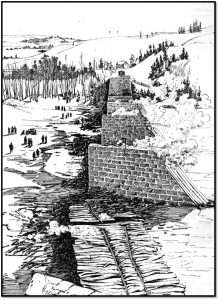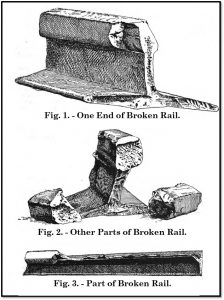The Central Vermont Railroad was chartered on October 21, 1843, to run from Burlington on Lake Champlain to Windsor on the Connecticut River via St. Albans and Montpelier, the state Capital. It was opened to traffic at various times in 1849. It crossed the White River, a tributary of the Connecticut River about four miles north of White River Junction between Woodstock and West Hartford. A major high bridge was built across the river consisting of four spans of 140 feet and a short span of 70 feet, with a total length of approximately 630 feet on a large skew to the river. It was a 26-foot-deep, single track, double Towne lattice deck bridge, made of plank and strengthened by heavy timber arches with the piers and abutments built of granite. It was covered on the sides and top to protect the trussing from the weather. Its top was also covered with iron plates to minimize the chance of fire. From the track to the surface of the ice (water) was 42 feet, with the bottom of the trusses 16 feet from the river’s surface. The bridge was considered by many to be a fine example of bridge design and construction.
All was well with the bridge until the early morning of February 5, 1887, when what was called “the worst railroad accident in Vermont history” occurred. The express train from Boston to Montreal, Canada, consisted of an engine, one baggage car, one express car, one mail car, two ordinary passenger coaches, the sleeping car St. Albans, and the Pullman sleeper Pilgrim, from Boston. The St. Albans carried about twenty-six passengers, and the Pilgrim about forty passengers. Besides these passengers, there were about fifty people in the passenger coaches. The train was running late on a bitterly cold night, -20°F, and reached the bridge around 3:00 AM. What happened next was told in the Frank Leslie Illustrated Newspaper, with an engraving of a burning car on the cover, as follows,

“It was at this point that the train met its fate – a broken rail 200 feet from the bridge being the cause. Whether the train broke the frosty rail, throwing the cars from the track, whether the rail was broken before the train arrived, or whether some wheel gave way and snapped the rail is not known and may never be known.
In an instant there was a jar, a bumping of tracks over the railroad ties. The coupling between the forward sleeper and the four following cars broke, the engine, baggage and smoking cars passed on to the bridge and over in safety but the other four cars bumped along over the ties to the end of the bridge, knocked out the heavy timbers which rested on the abutment, and then toppled over bridge, cars and human freight, fully eighty souls all told, falling with a tremendous crash down the jagged precipice seventy feet striking upon the frozen surface of the river.
Then followed a scene which beggars all power of human description. The splintered wreck took fire, and the dark gorge, from which the moon was hidden, was soon lighted up by the glare of burning coaches and bridge timbers. The detached portion of the train was stopped and run back to the scene as soon as possible. Those on board sprang into the deep snow and made their way as best they could down the steep banks to assist any in the wreck who were alive…Many were pinned beneath huge timbers, beyond all human aid.”
In those days, the cars were heated by coal-burning stoves placed in the cars periodically and were lighted with sperm oil lamps. When the cars crashed onto the ice, the stoves were upset and burned the wooden coaches. The fire was so intense it ignited the wooden bridge above, and eventually the entire bridge collapsed into the river.
Fortunately, for the record, Robert Fletcher, a civil engineering professor at Dartmouth College, visited the site on the next day and submitted a report published in the Engineering News on February 12 with illustrations. He wrote in part,
“The testimony of escaped passengers shows that the rear car, and perhaps also the next one, became derailed when within a few rods of the bridge. The testimony of the engineer is to the effect that when the locomotive was partway across the bridge the rope was pulled…The three cars in advance of the rear one were turned and dragged off in quick succession, rolling over and falling upside down on the ice, where they lay extended from near the south abutment to a point a little beyond the second pier…

Going to the embankment by which the south abutment is approached, it was found that the inside rail of the slight curve leading toward the bridge had been entirely re-laid that morning from the bridge to a point about 450 to 470 feet distant – sixteen or seventeen rail lengths. At intervals from this point, the ties were scratched and deeply cut nearly across the whole width, between the rails and also on the outside or to the right of the easterly rail, out to the ends of the ties, as the bridge was approached. Whatever marks may have been made in the snow and the frozen ground had been obliterated by the tramping of feet. Just outside the track, the snow was from 1 to 8 feet deep. On the east side, …was a pile of rail fragments, pieces of two or three rails, all but covered by snow. A few feet farther on were more fragments of one, and perhaps of two, rails. Whether all of the pieces were due to the accident, or some resulted from the work of the section hands in re-laying the track, we have not ascertained…
These are the principal facts relevant to the case…However, in the opinion of your correspondent, the evidence seems to point to the failure of a rail about 450 feet from the end of the bridge as the beginning. Whether this failed partly under the locomotive or under one of the forward cars, we can only guess, but the battered condition of the ends of some of the fragments indicates that they had been struck by two or more trucks or wheels, which may have succeeded in mounting and passing over them.”
Engineering News ran articles on the failure for months. They were promoting the Latimer re-railing system and wrote of the failure that it,
“…belongs to the class of accidents which may be most easily, cheaply, and certainly prevented. That this particular disaster could, with certainty, have been prevented, it is beyond human knowledge to declare, but the multiplied instances in which trains derailed, as this one was, just before reaching a bridge, have been replaced upon the rails and all disaster avoided by the Latimer re-railing bridge safety-guard justifies a belief that the chances were many to one that a few pounds of cast iron and a few feet of timber arranged in the manner which we illustrate on another page, would have saved every one of the forty or fifty lives which appear to have been lost, and the thirty or more injured.”
They later wrote a long article entitled, The Cause of the Woodstock Disaster and its Lessons, and concluded,
“Thus we find that this accident, in all human probability, was a case of broken rail derailment pure and simple, with or without the early breakage of a single axle of the rear truck, as a secondary consequence of its more erratic movements and more violent blows…The lesson of this disaster then is plain, and let us hope that it will sink into the minds and hearts of engineers so that they will never forget it. Good practice spreads slowly when it involves expense without immediate return or urgent necessity, and not wholly without reason. But he who studies the facts of this and other cases and then neglects hereafter to avail himself of that cheap defense of railroad trains, the cast iron watchman which we illustrate, which neither sleeps nor eats, nor asks for pay, but is always faithful and always on hand, will be little short of a criminal unless he can extract a very different moral from the facts from what we can.”
The Railroad Commissioners of the State of Vermont launched an in-depth study of why the accident occurred. They interviewed survivors, train crew, etc. They submitted their report later in February, and an extract was published in the Railway Review on February 26, 1887. They found,
“The distance from White River Junction to the Hartford (formerly known as the Woodstock) bridge is about four miles. South of the bridge is a curve of 3 degrees 45 minutes in the track, which becomes straight again about 142 feet from the bridge and so continues for some rods beyond the bridge. From a point some 50 rods south of the bridge to a point about 142 feet therefrom, the grade is slightly downward when it becomes level and so continues to a point just beyond the bridge.”
They made the following recommendations,
“Upon the subject of recommendations, the board is not prepared to report fully. There is no ground of doubt that many who perished in this accident would have been released from the wreck alive had it not been for the stove fires and oil lamps which ignited the varnish, paint, draperies and other combustible material, almost as soon as the crash came, and caused the suffocation and burning of those who were pinioned beneath the rubbish before they could be extricated…Unless some better system is adopted by the roads of the state before another winter, as at present advised, the adoption of steam heating from the locomotives or other device without fires in the cars will be recommended by the board; and we do most earnestly recommend to the officials of the roads of the state in behalf of the corporate as well as public interests that they give especial attention to this subject by conference with officials of roads with which they have connection or business relations and by affording opportunities for experiment upon such inventions as seem to present promise of value in the direction of safety from fire and suffocation, in cases of derailment and collision…But it seems proper at this time, and upon this matter, to advise all the railroad companies of the state to take into consideration the most approved methods in vogue anywhere for the better equipment of their bridge approaches where needed, with strong buttresses, flaring safety beams, or other practical devices to diminish the fatality of this class of accidents. Such reasonable precautions should be taken before rather than after the occurrence of any fatal calamity.”
Lawsuits against the railroad went on for years, and it is not known what exact amount the line paid out. The greatest dangers to wooden bridges were fire, flood, decay, and derailment. In this case, it was a combination of fire and derailment. However, the fire was different as burning cars from below set the bridge on fire, and the derailment did not cause the bridge to collapse but only to result in the rear cars sliding off the bridge on the iron cover plates.■
